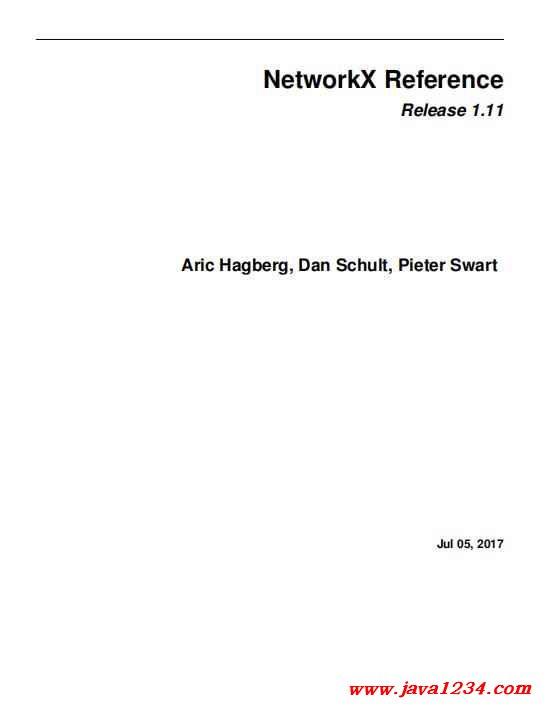| 失效链接处理 |
|
Network使用手册 PDF 下载
本站整理下载:
提取码:5hc4
相关截图:

主要内容:
1.1 Who uses NetworkX?
The potential audience for NetworkX includes mathematicians, physicists, biologists, computer scientists, and social
scientists. Good reviews of the state-of-the-art in the science of complex networks are presented in Albert and Barabási
[BA02], Newman [Newman03], and Dorogovtsev and Mendes [DM03]. See also the classic texts [Bollobas01],
[Diestel97] and [West01] for graph theoretic results and terminology. For basic graph algorithms, we recommend the
texts of Sedgewick, e.g. [Sedgewick01] and [Sedgewick02] and the survey of Brandes and Erlebach [BE05].
1.2 Goals
NetworkX is intended to provide
• tools for the study of the structure and dynamics of social, biological, and infrastructure networks,
• a standard programming interface and graph implementation that is suitable for many applications,
• a rapid development environment for collaborative, multidisciplinary projects,
• an interface to existing numerical algorithms and code written in C, C++, and FORTRAN,
• the ability to painlessly slurp in large nonstandard data sets.
1
NetworkX Reference, Release 1.11
1.3 The Python programming language
Python is a powerful programming language that allows simple and flexible representations of networks, and clear and
concise expressions of network algorithms (and other algorithms too). Python has a vibrant and growing ecosystem
of packages that NetworkX uses to provide more features such as numerical linear algebra and drawing. In addition
Python is also an excellent “glue” language for putting together pieces of software from other languages which allows
reuse of legacy code and engineering of high-performance algorithms [Langtangen04].
Equally important, Python is free, well-supported, and a joy to use.
In order to make the most out of NetworkX you will want to know how to write basic programs in Python. Among
the many guides to Python, we recommend the documentation at http://www.python.org and the text by Alex Martelli
[Martelli03].
1.4 Free software
NetworkX is free software; you can redistribute it and/or modify it under the terms of the BSD License. We welcome
contributions from the community. Information on NetworkX development is found at the NetworkX Developer Zone
at Github https://github.com/networkx/networkx
1.5 History
NetworkX was born in May 2002. The original version was designed and written by Aric Hagberg, Dan Schult, and
Pieter Swart in 2002 and 2003. The first public release was in April 2005.
Many people have contributed to the success of NetworkX. Some of the contributors are listed in the credits.
1.5.1 What Next
• A Brief Tour
• Installing
• Reference
• Examples
2 Chapter 1. Overview
CHAPTER 2
Introduction
The structure of NetworkX can be seen by the organization of its source code. The package provides classes for graph
objects, generators to create standard graphs, IO routines for reading in existing datasets, algorithms to analyse the
resulting networks and some basic drawing tools.
Most of the NetworkX API is provided by functions which take a graph object as an argument. Methods of the graph
object are limited to basic manipulation and reporting. This provides modularity of code and documentation. It also
makes it easier for newcomers to learn about the package in stages. The source code for each module is meant to be
easy to read and reading this Python code is actually a good way to learn more about network algorithms, but we have
put a lot of effort into making the documentation sufficient and friendly. If you have suggestions or questions please
contact us by joining the NetworkX Google group.
Classes are named using CamelCase (capital letters at the start of each word). functions, methods and variable names
are lower_case_underscore (lowercase with an underscore representing a space between words).
2.1 NetworkX Basics
|




 苏公网安备 32061202001004号
苏公网安备 32061202001004号



